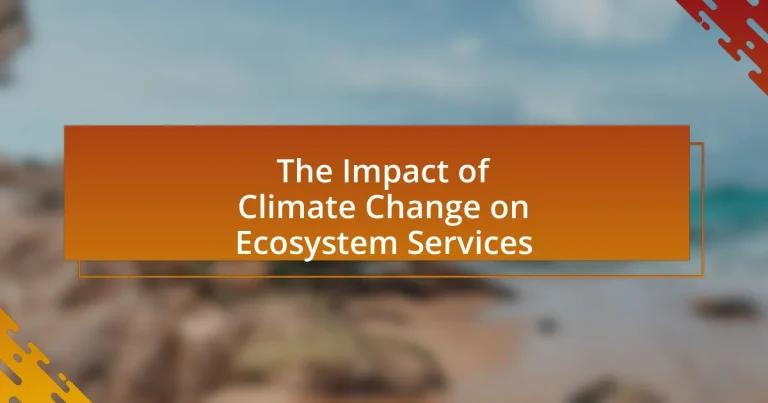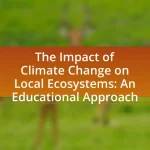Ecosystem services are the essential benefits that humans obtain from natural ecosystems, categorized into provisioning, regulating, cultural, and supporting services. Climate change poses significant threats to these services by altering ecosystems’ structure and function, leading to reduced biodiversity and diminished productivity. The article examines how climate change impacts food security, agricultural productivity, and local economies, while also highlighting the importance of conservation efforts and sustainable practices to mitigate these effects. Key strategies for preserving ecosystem services include enhancing biodiversity, implementing sustainable land management, and restoring degraded ecosystems, which are crucial for maintaining ecological balance and supporting human well-being.
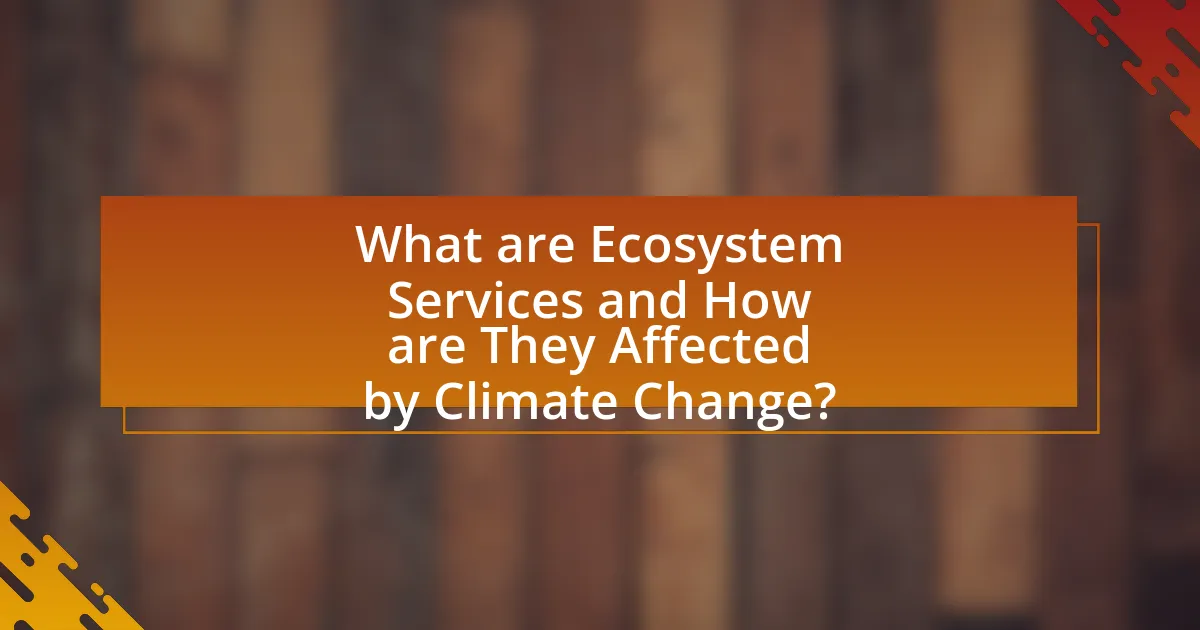
What are Ecosystem Services and How are They Affected by Climate Change?
Ecosystem services are the benefits that humans derive from natural ecosystems, including provisioning services like food and water, regulating services such as climate regulation and flood control, cultural services that provide recreational and spiritual benefits, and supporting services like nutrient cycling and soil formation. Climate change significantly affects these services by altering ecosystems’ structure and function, leading to reduced biodiversity, shifts in species distributions, and changes in ecosystem productivity. For instance, a study published in “Nature Climate Change” by IPCC in 2021 indicates that climate change could lead to a decline in agricultural yields by up to 30% in some regions by 2050, directly impacting food provisioning services. Additionally, increased frequency of extreme weather events can disrupt regulating services, such as flood control, resulting in greater vulnerability to natural disasters.
What are the different types of ecosystem services?
Ecosystem services are categorized into four main types: provisioning, regulating, cultural, and supporting services. Provisioning services include the production of food, water, and raw materials, which are essential for human survival and economic activity. Regulating services encompass climate regulation, flood control, and disease regulation, contributing to the stability of ecosystems and human health. Cultural services provide recreational, aesthetic, and spiritual benefits, enhancing human well-being and cultural identity. Supporting services, such as nutrient cycling and soil formation, are fundamental for the production of all other ecosystem services. These classifications are widely recognized in environmental science, as outlined in the Millennium Ecosystem Assessment, which emphasizes the importance of these services for sustainable development and human welfare.
How do provisioning services contribute to human well-being?
Provisioning services contribute to human well-being by providing essential resources such as food, water, and raw materials. These services support nutrition, health, and economic stability, directly impacting quality of life. For instance, according to the Food and Agriculture Organization, sustainable agricultural practices enhance food security, which is crucial for reducing hunger and improving health outcomes. Additionally, freshwater ecosystems supply drinking water, vital for survival and sanitation, thereby promoting public health. The availability of these resources is directly linked to ecosystem health, which is increasingly threatened by climate change, highlighting the importance of maintaining these services for ongoing human well-being.
What role do regulating services play in maintaining ecological balance?
Regulating services are essential for maintaining ecological balance as they control natural processes and mitigate environmental changes. These services include climate regulation, water purification, and disease control, which collectively help sustain biodiversity and ecosystem health. For instance, forests act as carbon sinks, absorbing carbon dioxide and thus regulating the climate, while wetlands filter pollutants from water, enhancing water quality. The loss of these regulating services due to climate change can lead to increased flooding, reduced air quality, and the spread of diseases, demonstrating their critical role in sustaining ecological integrity.
Why are cultural services important for communities?
Cultural services are important for communities because they enhance social cohesion, identity, and well-being. These services, which include recreational activities, cultural heritage, and artistic expression, foster a sense of belonging and community pride. For instance, studies show that access to cultural services can improve mental health and increase community engagement, leading to stronger social networks. Additionally, cultural services contribute to local economies by attracting tourism and supporting local artists and businesses, thereby reinforcing the community’s economic resilience.
How does climate change impact the availability of ecosystem services?
Climate change significantly reduces the availability of ecosystem services by altering habitats, affecting biodiversity, and disrupting natural processes. For instance, rising temperatures and changing precipitation patterns can lead to habitat loss, which diminishes the ability of ecosystems to provide services such as water purification, pollination, and carbon sequestration. A study published in “Nature Climate Change” by IPCC in 2021 indicates that up to 30% of species are at risk of extinction due to climate-related changes, which directly impacts the services ecosystems offer. Additionally, increased frequency of extreme weather events, such as floods and droughts, further strains these services, making them less reliable for human use and ecological balance.
What specific changes in climate are most detrimental to ecosystem services?
Specific changes in climate that are most detrimental to ecosystem services include increased temperatures, altered precipitation patterns, and rising sea levels. Increased temperatures can lead to heat stress in plants and animals, disrupting food webs and reducing biodiversity. Altered precipitation patterns can cause droughts or flooding, affecting water availability and soil health, which are critical for agriculture and natural ecosystems. Rising sea levels threaten coastal ecosystems, such as mangroves and wetlands, which provide essential services like flood protection and habitat for marine life. These changes have been documented in various studies, including the Intergovernmental Panel on Climate Change (IPCC) reports, which highlight the direct impacts of climate change on ecosystem functionality and service provision.
How do alterations in temperature and precipitation patterns affect biodiversity?
Alterations in temperature and precipitation patterns significantly affect biodiversity by disrupting ecosystems and species interactions. Changes in temperature can lead to shifts in species distributions, as many organisms are unable to adapt quickly enough to new climatic conditions, resulting in habitat loss and increased extinction rates. For instance, a study published in “Nature” by Parmesan and Yohe (2003) found that 50% of species studied in various regions have already shifted their ranges poleward or to higher elevations due to climate change. Additionally, altered precipitation patterns can affect water availability, impacting plant growth and food resources for herbivores, which in turn affects predator populations. Research from the Intergovernmental Panel on Climate Change (IPCC) indicates that changes in rainfall patterns can lead to habitat degradation, further threatening biodiversity.
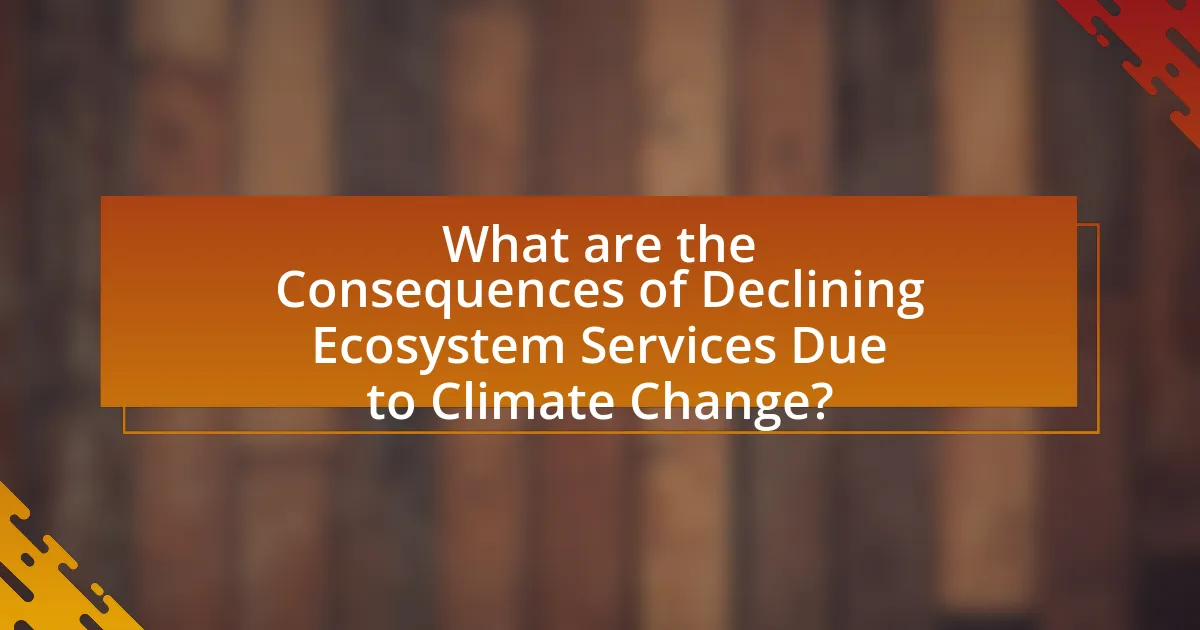
What are the Consequences of Declining Ecosystem Services Due to Climate Change?
The consequences of declining ecosystem services due to climate change include loss of biodiversity, reduced food security, and increased vulnerability to natural disasters. As ecosystems deteriorate, species extinction rates rise, with studies indicating that climate change could lead to the extinction of up to one million species by 2050. This loss of biodiversity disrupts food webs and diminishes the availability of natural resources, leading to food insecurity for millions globally. Furthermore, weakened ecosystems, such as forests and wetlands, are less effective at mitigating floods and regulating climate, resulting in heightened risks of extreme weather events. For instance, the Intergovernmental Panel on Climate Change (IPCC) reports that climate change has already increased the frequency and intensity of extreme weather, which can devastate communities and economies.
How does the loss of ecosystem services affect food security?
The loss of ecosystem services significantly undermines food security by disrupting the natural processes that support agricultural productivity. Ecosystem services, such as pollination, soil fertility, and water regulation, are essential for growing crops and raising livestock. For instance, a study published in the journal “Nature” found that pollinators contribute to the production of over 75% of the world’s food crops, highlighting their critical role in food systems. When these services decline due to factors like habitat destruction or climate change, crop yields can decrease, leading to food shortages and increased prices. Additionally, the degradation of ecosystems can result in soil erosion and reduced water quality, further compromising agricultural output and food availability.
What are the implications for agricultural productivity?
Climate change significantly impacts agricultural productivity by altering weather patterns, affecting crop yields, and increasing the frequency of extreme weather events. For instance, rising temperatures can lead to heat stress in crops, reducing their growth and yield potential. According to a study published in “Nature Climate Change,” global crop yields could decline by up to 25% by 2050 due to climate-related factors. Additionally, changes in precipitation patterns can lead to droughts or flooding, further jeopardizing food production. These shifts necessitate adaptive strategies in agriculture to maintain productivity levels amidst changing environmental conditions.
How does reduced biodiversity impact food systems?
Reduced biodiversity negatively impacts food systems by diminishing the resilience and stability of agricultural ecosystems. When biodiversity is low, crops and livestock become more susceptible to pests, diseases, and climate variability, leading to decreased yields. For instance, a study published in the journal “Nature” found that diverse ecosystems can produce 20-30% more food than monocultures due to enhanced ecosystem services such as pollination and nutrient cycling. Additionally, reduced genetic diversity within crops limits their ability to adapt to changing environmental conditions, further threatening food security.
What economic impacts arise from diminished ecosystem services?
Diminished ecosystem services lead to significant economic impacts, including reduced agricultural productivity, increased costs for water purification, and heightened disaster recovery expenses. For instance, the decline in pollinator populations can result in lower crop yields, which directly affects food supply and prices. A study by the Intergovernmental Science-Policy Platform on Biodiversity and Ecosystem Services (IPBES) estimates that the global economic value of pollination services is around $235 to $577 billion annually. Additionally, the loss of wetlands reduces natural water filtration, forcing municipalities to invest in costly water treatment infrastructure. The National Oceanic and Atmospheric Administration (NOAA) reports that every dollar spent on coastal ecosystem restoration can save $4 in disaster recovery costs, highlighting the financial burden of ecosystem service loss.
How do changes in ecosystem services affect local economies?
Changes in ecosystem services significantly affect local economies by altering resource availability and economic productivity. For instance, a decline in pollination services due to habitat loss can lead to reduced agricultural yields, impacting farmers’ incomes and local food supply. According to the Intergovernmental Science-Policy Platform on Biodiversity and Ecosystem Services (IPBES), approximately 75% of global food crops rely on animal pollination, highlighting the economic importance of these services. Additionally, changes in water quality and availability can affect fisheries and tourism, further straining local economies that depend on these sectors. The economic repercussions of such changes can lead to job losses, decreased revenue, and increased poverty in affected communities.
What are the long-term financial implications for industries reliant on natural resources?
Industries reliant on natural resources face significant long-term financial implications due to climate change, including increased operational costs, resource scarcity, and regulatory pressures. As climate change leads to extreme weather events and shifts in ecosystems, these industries may experience disruptions in supply chains and higher costs for raw materials. For instance, the agricultural sector has seen a 20% increase in costs related to climate adaptation measures, such as irrigation and pest management, as reported by the Intergovernmental Panel on Climate Change. Additionally, industries may incur costs from compliance with stricter environmental regulations aimed at reducing carbon emissions, which can further strain financial resources. Overall, the financial sustainability of these industries is increasingly threatened by the ongoing impacts of climate change.
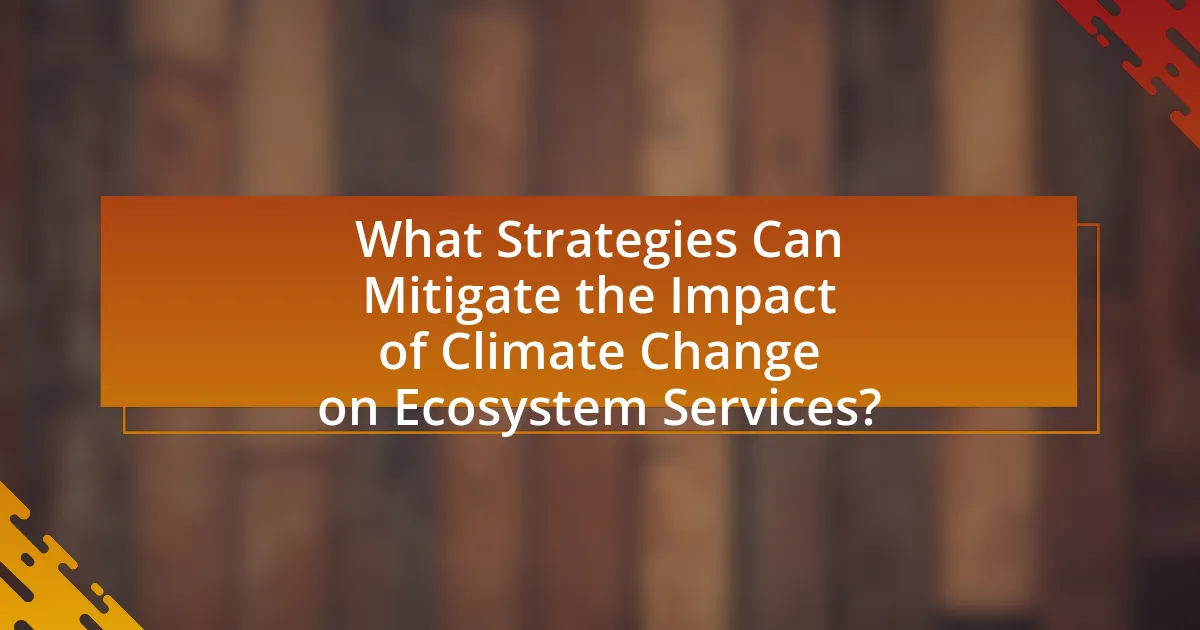
What Strategies Can Mitigate the Impact of Climate Change on Ecosystem Services?
Strategies that can mitigate the impact of climate change on ecosystem services include enhancing biodiversity, implementing sustainable land management practices, and restoring degraded ecosystems. Enhancing biodiversity increases ecosystem resilience, allowing systems to better withstand climate-related stresses; for example, diverse plant species can improve soil health and water retention. Sustainable land management practices, such as agroforestry and conservation agriculture, reduce soil erosion and enhance carbon sequestration, which is crucial for climate mitigation. Restoring degraded ecosystems, such as wetlands and forests, can improve water quality and provide habitat for wildlife, thereby supporting ecosystem services. According to the Intergovernmental Panel on Climate Change (IPCC), these strategies are essential for maintaining ecosystem functionality and supporting human well-being in the face of climate change.
How can conservation efforts help preserve ecosystem services?
Conservation efforts can help preserve ecosystem services by protecting biodiversity and maintaining the health of natural habitats. Healthy ecosystems provide essential services such as clean water, pollination, and carbon sequestration, which are vital for human survival and environmental stability. For instance, the World Resources Institute reports that conserving forests can enhance water quality and regulate water cycles, directly benefiting agricultural productivity and human health. Additionally, protecting wetlands can mitigate flooding and improve water filtration, demonstrating the direct link between conservation and the preservation of ecosystem services.
What role do protected areas play in maintaining ecosystem services?
Protected areas play a crucial role in maintaining ecosystem services by conserving biodiversity and providing habitats essential for various species. These areas help regulate climate, purify water, and support pollination, which are vital for agricultural productivity and human well-being. For instance, a study published in “Nature” by Benstad et al. (2020) found that protected areas significantly enhance carbon storage, thereby mitigating climate change impacts. Additionally, protected areas safeguard ecosystems from degradation, ensuring the continued provision of services such as flood regulation and soil fertility, which are increasingly threatened by climate change.
How can restoration projects enhance ecosystem resilience?
Restoration projects enhance ecosystem resilience by rehabilitating degraded habitats, which improves biodiversity and ecosystem functions. For instance, reforestation efforts can increase carbon sequestration, thereby mitigating climate change impacts. A study published in “Nature” by Benayas et al. (2009) found that restored ecosystems often exhibit greater species diversity and improved soil health, which are critical for resilience against environmental stressors. Additionally, these projects can restore natural water cycles and enhance the ability of ecosystems to withstand extreme weather events, further solidifying their resilience.
What practices can individuals and communities adopt to support ecosystem services?
Individuals and communities can adopt practices such as sustainable land use, conservation of natural habitats, and promoting biodiversity to support ecosystem services. Sustainable land use includes implementing agroecological practices that enhance soil health and reduce chemical inputs, which can improve food production while preserving ecosystem functions. Conservation of natural habitats, such as wetlands and forests, protects essential services like water filtration and carbon storage. Promoting biodiversity through community gardens and native plant landscaping fosters resilience against climate change impacts, as diverse ecosystems are better equipped to adapt to environmental changes. These practices are supported by research indicating that biodiversity loss can significantly impair ecosystem services, highlighting the importance of community engagement in conservation efforts.
How can sustainable land management practices contribute to ecosystem health?
Sustainable land management practices enhance ecosystem health by promoting biodiversity, improving soil quality, and conserving water resources. These practices, such as crop rotation, agroforestry, and reduced tillage, help maintain ecological balance by supporting a variety of plant and animal species, which in turn contributes to resilience against climate change. For instance, a study published in the journal “Ecological Applications” found that agroecological practices can increase biodiversity by up to 30%, leading to healthier ecosystems. Additionally, sustainable practices improve soil structure and fertility, which enhances carbon sequestration and reduces greenhouse gas emissions, further supporting ecosystem health.
What are some effective community initiatives for promoting ecosystem services?
Effective community initiatives for promoting ecosystem services include urban reforestation projects, community gardens, and watershed management programs. Urban reforestation projects enhance biodiversity and improve air quality by increasing tree cover, which has been shown to reduce urban heat islands and sequester carbon. Community gardens foster local food production and enhance soil health, contributing to ecosystem resilience. Watershed management programs protect water quality and promote sustainable land use practices, which are essential for maintaining ecosystem services such as clean water supply and flood regulation. These initiatives have been supported by studies indicating their positive impact on local ecosystems and community well-being.
What are the best practices for adapting to climate change impacts on ecosystem services?
The best practices for adapting to climate change impacts on ecosystem services include enhancing ecosystem resilience, implementing sustainable land management, and promoting biodiversity conservation. Enhancing ecosystem resilience involves restoring degraded ecosystems, which can improve their ability to withstand climate stressors. Sustainable land management practices, such as agroforestry and conservation tillage, help maintain soil health and water quality, thereby supporting ecosystem services. Promoting biodiversity conservation is crucial, as diverse ecosystems are more resilient to climate change; for instance, studies show that ecosystems with higher species diversity can better recover from disturbances. These practices collectively contribute to maintaining and improving ecosystem services in the face of climate change.
